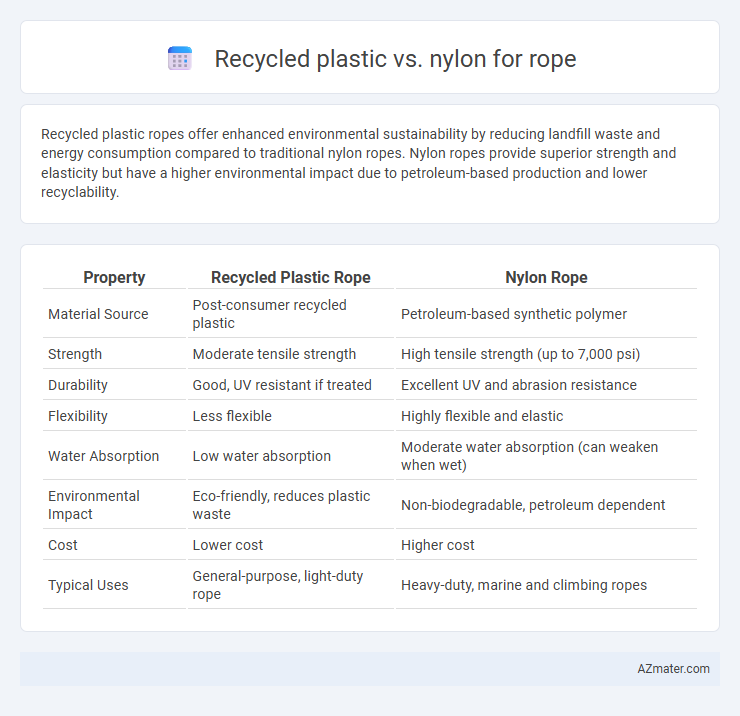Recycled plastic ropes offer enhanced environmental sustainability by reducing landfill waste and energy consumption compared to traditional nylon ropes. Nylon ropes provide superior strength and elasticity but have a higher environmental impact due to petroleum-based production and lower recyclability.
Table of Comparison
| Property | Recycled Plastic Rope | Nylon Rope |
|---|---|---|
| Material Source | Post-consumer recycled plastic | Petroleum-based synthetic polymer |
| Strength | Moderate tensile strength | High tensile strength (up to 7,000 psi) |
| Durability | Good, UV resistant if treated | Excellent UV and abrasion resistance |
| Flexibility | Less flexible | Highly flexible and elastic |
| Water Absorption | Low water absorption | Moderate water absorption (can weaken when wet) |
| Environmental Impact | Eco-friendly, reduces plastic waste | Non-biodegradable, petroleum dependent |
| Cost | Lower cost | Higher cost |
| Typical Uses | General-purpose, light-duty rope | Heavy-duty, marine and climbing ropes |
Introduction: Comparing Recycled Plastic and Nylon Ropes
Recycled plastic ropes offer an eco-friendly alternative to traditional nylon ropes by utilizing waste materials, reducing environmental impact while maintaining durability. Nylon ropes, known for their high tensile strength, elasticity, and resistance to abrasion, remain a preferred choice in demanding industrial and marine applications. Comparing these materials involves assessing factors such as strength, environmental sustainability, UV resistance, and cost-effectiveness for various rope uses.
Material Sources: How Recycled Plastic and Nylon Are Made
Recycled plastic rope is produced by repurposing post-consumer plastic waste, such as PET bottles, which undergo cleaning, shredding, and melting processes before being extruded into fibers. Nylon rope originates from synthetic polymers derived from petrochemicals, primarily through a polymerization process of caprolactam or hexamethylene diamine and adipic acid. The environmental impact of recycled plastic rope is significantly lower due to waste reduction and resource reuse, while nylon production relies on non-renewable fossil fuels with higher carbon emissions.
Strength and Durability: Which Rope Performs Better?
Recycled plastic ropes often exhibit excellent resistance to UV rays and abrasion, making them highly durable for outdoor use, while nylon ropes are known for superior tensile strength and elasticity, absorbing shock loads effectively. Nylon's ability to stretch under load helps prevent snapping, though it can degrade faster when exposed to prolonged sunlight compared to UV-stabilized recycled plastic. For applications requiring maximum strength and flexibility, nylon ropes typically outperform recycled plastic, but for long-term durability in harsh environmental conditions, recycled plastic ropes provide a more resilient option.
Environmental Impact: Sustainability of Recycled Plastic vs Nylon
Recycled plastic ropes significantly reduce environmental footprint by diverting plastic waste from landfills and oceans, promoting circular economy practices. Nylon production relies heavily on petrochemicals, contributing to carbon emissions and non-renewable resource depletion. Using recycled plastic materials enhances sustainability by lowering energy consumption and reducing greenhouse gas emissions compared to traditional nylon manufacturing.
Resistance to Weather and UV Exposure
Recycled plastic ropes exhibit superior resistance to weather and UV exposure compared to nylon, maintaining strength and flexibility even after prolonged outdoor use. Nylon fibers tend to degrade and lose tensile strength when exposed to sunlight and moisture over time. The enhanced UV stabilization in recycled plastic makes it a more durable choice for applications requiring long-term exposure to harsh environmental conditions.
Flexibility and Handling Differences
Recycled plastic ropes typically offer greater stiffness compared to nylon, resulting in reduced flexibility and a firmer grip during handling. Nylon ropes excel in elasticity and softness, providing superior flexibility that enhances knot tying and user comfort. The choice between recycled plastic and nylon ropes impacts handling performance based on their intrinsic material flexibility characteristics.
Cost Comparison: Recycled Plastic vs Nylon Ropes
Recycled plastic ropes generally offer a cost advantage over nylon ropes, as they are made from repurposed materials that reduce raw material expenses. Nylon ropes tend to be more expensive due to the energy-intensive production process and higher durability performance. For budget-conscious applications, recycled plastic ropes provide an economical alternative without significantly compromising strength and flexibility.
Applications: Best Uses for Each Rope Type
Recycled plastic ropes excel in marine and outdoor applications due to their resistance to UV rays, moisture, and chemicals, making them ideal for boating, fishing nets, and garden ties. Nylon ropes offer superior elasticity and strength, suited for climbing, towing, and rescue operations where shock absorption and durability under dynamic loads are critical. Each type leverages specific material properties to optimize performance in their respective industrial and recreational uses.
Safety Considerations and Load Ratings
Recycled plastic ropes offer environmental benefits but typically have lower tensile strength and inconsistent load ratings compared to nylon ropes, which provide superior durability and higher safe working loads. Nylon ropes exhibit excellent elongation, shock absorption, and resistance to abrasion, making them preferable for safety-critical applications requiring reliable load-bearing capacity. Careful evaluation of tensile strength, elongation properties, and standardized load ratings is essential when selecting rope material to ensure optimal safety performance for intended use.
Conclusion: Choosing the Right Rope for Your Needs
Recycled plastic ropes provide an eco-friendly alternative with good durability and resistance to UV and water, making them ideal for marine and outdoor applications. Nylon ropes offer superior strength, elasticity, and abrasion resistance, preferred for heavy-duty use and load-bearing tasks. Selecting the right rope depends on the balance between environmental impact, cost, and specific performance requirements for your project.

Infographic: Recycled plastic vs Nylon for Rope
 azmater.com
azmater.com